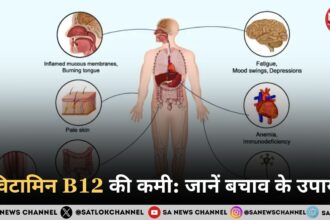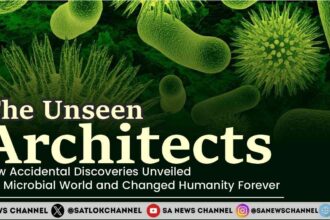Have you ever thought about why you resemble your parents? Or why certain illnesses appear to be common in families? The explanations are found in the intriguing field of human genetics — which examines how characteristics are inherited from one generation to another through small instructions in our bodies.
- Structure and Function of DNA
- Genes and Chromosomes
- Principles of Heredity and Inheritance
- The Human Genome Project and Genetic Mapping
- Genetic Mutations and Their Effects
- Common Genetic Disorders in Humans
- Genetic Testing and Counseling
- Advances in Genetic Engineering and Gene Therapy
- Ethical Considerations in Human Genetics
- Conclusion: The Future of Human Genetics
- Sant Rampal Ji Maharaj’s Gyan on Human Genetics and the Soul’s Journey to Satlok
- Connect With Us on the Following Social Media Platforms
Human genetics helps us understand the role of DNA structure, genes and chromosomes, and the basic rules of heredity and inheritance. It explains how genetic changes, called mutations, can affect health, and how modern science uses genetic testing and genetic engineering to prevent or treat genetic diseases.
This blog will guide you through the essential ideas of human genetics, explaining everything in simple language. Whether you’re a student, beginner, or just curious, by the end, you’ll have a solid understanding of what makes us genetically unique and how this knowledge is transforming medicine and biology.
Structure and Function of DNA
What is DNA?
DNA, which stands for deoxyribonucleic acid, is the molecule that contains all the genetic information for living beings. Think of it as the blueprint for building and running your body. DNA contains the instructions cells use to make proteins, which are the building blocks for body parts and perform important functions like digesting food or fighting infections.
Each human cell contains about two meters of DNA tightly packed inside its nucleus. Despite its size, DNA fits into this tiny space because it is folded and coiled into complex shapes.
DNA Double Helix and Nucleotides
The structure of DNA is known as a double helix, resembling a twisted ladder.
- The sides of the ladder are made of sugar and phosphate molecules.
- The rungs of the ladder are made of pairs of chemicals called nucleotides or bases.
- There are four types of bases: Adenine (A), Thymine (T), Cytosine (C), and Guanine (G).
- Bases always pair in a specific way: A pairs with T, and C pairs with G.
This pairing is essential for DNA’s function because it allows the DNA molecule to be copied precisely during cell division.
The sequence of these bases is like letters in a language, forming codes that instruct cells which proteins to build and when to build them. This code is the foundation of all life processes.
Genes and Chromosomes
Definition of Genes
A gene is a part of DNA that contains the instructions to create a particular protein. Each gene controls particular traits or functions in your body, like the color of your eyes or how your body fights diseases.
Humans have roughly 20,000 to 25,000 genes. These genes act like chapters in a giant instruction book, each with a specific role.
Human Chromosome Number and Types
DNA does not float freely in the cell but is organized into thread-like structures called chromosomes.
- Humans have 46 chromosomes arranged in 23 pairs.
- Each parent contributes one chromosome to each pair, so you inherit half of your chromosomes from your mother and half from your father.
- 22 pairs are called autosomes, which contain most of your genes.
- The 23rd pair consists of the sex chromosomes (XX for females and XY for males), which decide biological sex.
Chromosomes keep DNA organized and ensure it is copied correctly when cells divide.
Principles of Heredity and Inheritance
Mendelian Genetics
The rules of heredity were first discovered by Gregor Mendel in the 19th century. By studying pea plants, Mendel found that traits are inherited in predictable ways through “units” we now call genes.
He suggested that genes exist in pairs, with one coming from each parent. Some genes are dominant, meaning they show their trait even if only one copy is present. Others are recessive, meaning they only show if both copies are recessive.
Dominant and Recessive Traits
For example, consider the gene for eye color:
- Brown eyes are usually dominant over blue eyes.
- If you receive one gene for brown eyes and one for blue eyes, your eyes will be brown.
- You only get blue eyes if you inherit two blue eye genes, one from each parent.
Dominant and recessive genes explain why children may have traits that skip generations or differ from their parents.
Punnett Squares Explained
A Punnett square is an easy tool used to forecast potential gene combinations in offspring.
For example, if both parents carry one dominant gene (B for brown eyes) and one recessive gene (b for blue eyes), the Punnett square shows the chances of their children inheriting different eye colors:
| B (from mom) | b (from mom) | |
| B (dad) | BB (Brown) | Bb (Brown) |
| b (dad) | Bb (Brown) | bb (Blue) |
There is a 75% chance of brown eyes and 25% chance of blue eyes in this example.
The Human Genome Project and Genetic Mapping
The Human Genome Project (HGP) was a significant scientific initiative aimed at decoding the complete human genetic blueprint.
- Started in 1990 and completed in 2003.
- It mapped all the approximately 3 billion base pairs of human DNA.
- The HGP identified thousands of genes and their locations on chromosomes.
This mapping has revolutionized medicine by allowing scientists to find genes associated with diseases and develop targeted treatments. It also paved the way for personalized medicine, where treatments can be tailored to an individual’s genetic makeup.
Genetic Mutations and Their Effects
What is a Genetic Mutation?
A genetic mutation refers to a change in the DNA sequence. These changes can happen naturally during DNA copying or due to external factors like radiation or chemicals.
Mutations come in many types:
- Point mutations: a single base is changed.
- Insertions or deletions: bases are added or removed.
- Chromosomal mutations: large sections of chromosomes are altered.
Effects of Mutations
- Many mutations have no effect or are neutral.
- Some mutations can be beneficial and increase genetic diversity.
- Others cause genetic disorders or increase disease risk.
For example, a mutation in the gene that makes hemoglobin causes sickle cell anemia, a disease where red blood cells become misshapen and cannot carry oxygen efficiently.
Also Read: DNA Barcoding for River Blindness Management
Mutations are also the raw material for evolution, providing new traits that may help survival.
Common Genetic Disorders in Humans
Several diseases are caused by mutations in genes or abnormalities in chromosomes.
Here are some common genetic disorders:
- Cystic fibrosis: A mutation causes thick mucus in the lungs and digestive tract, leading to breathing and digestion problems.
- Sickle cell anemia: A mutation causes red blood cells to be shaped like a sickle, which can block blood flow.
- Down syndrome: Caused by an extra copy of chromosome 21, leading to developmental delays and intellectual disability.
- Tay-Sachs disease: A fatal genetic disorder causing nerve cell damage, especially common in certain populations.
These disorders often follow Mendelian inheritance patterns and can sometimes be predicted through family history and genetic testing.
Genetic Testing and Counseling
What is Genetic Testing?
Genetic testing analyzes DNA to detect mutations or changes that cause disease or increase risk.
Types of genetic testing include:
- Diagnostic testing: To verify or exclude a genetic disorder.
- Predictive testing: To assess the risk of developing a condition in the future.
- Carrier testing: To see if a person carries a gene for a recessive disease.
- Prenatal testing: To check the health of a fetus.
Why Genetic Counseling is Important
After testing, genetic counseling helps individuals and families understand results and options.
- Counselors explain the meaning of test results.
- Discuss the chances of passing disorders to children.
- Help with emotional support and decision-making.
Genetic counseling is an important step before and after testing to make informed choices about health and family planning.
Advances in Genetic Engineering and Gene Therapy
Genetic Engineering
Genetic engineering is the process of changing DNA to add or remove traits.
New technologies like CRISPR-Cas9 have made gene editing easier and more precise.
Applications include:
- Developing crops resistant to pests and diseases.
- Creating animals with desirable traits.
- Researching treatments for genetic diseases.
Gene Therapy
Gene therapy aims to treat or cure genetic diseases by replacing faulty genes or adding new genes.
Examples:
- Treating inherited immune disorders.
- Research into curing cystic fibrosis, muscular dystrophy, and some cancers.
Though still developing, gene therapy holds enormous promise for future medicine.
Ethical Considerations in Human Genetics
With great power comes great responsibility. The ability to read and edit genes raises ethical questions:
- Should we allow gene editing in embryos?
- How do we protect individuals from genetic discrimination in jobs or insurance?
- Who owns genetic information?
Society must carefully balance scientific progress with respect for privacy, fairness, and human dignity.
Conclusion: The Future of Human Genetics
Human genetics has opened a window into the fundamental code of life. From understanding DNA structure to mapping the human genome, from discovering the patterns of heredity and inheritance to fighting genetic disorders, this field is rapidly advancing.
Technologies like genetic testing, genetic engineering, and gene therapy promise to revolutionize healthcare, but they also require careful ethical considerations.
As we continue to learn more about our genes, it is essential to:
- Recognize how genetics influence health and illness.
- Stay curious about new discoveries.
- Consider carefully the ethical impacts of genetic technology.
Human genetics is not just science — it is a key to understanding ourselves and improving our future.
Sant Rampal Ji Maharaj’s Gyan on Human Genetics and the Soul’s Journey to Satlok
While science studies human genetics, DNA, and heredity to explain physical traits and diseases, Sant Rampal Ji Maharaj reveals the deeper truth: the body is perishable, but the soul is eternal. Our real identity is the soul, not the body shaped by genes. The human body is a rare opportunity granted by Supreme God Kabir to escape the cycle of birth and death and attain Satlok, our true, immortal home.
Sant Rampal Ji explains that this material world, including our genetic structure, is under the influence of Maya and Karma. Diseases, beauty, and suffering are all results of past deeds—not merely DNA mutations. To free the soul from this trap, Sant Rampal Ji Maharaj provides Naam Diksha (Initiation) based on all holy scriptures (Gita, Bible, Quran, Guru Granth Sahib).
He gives true mantras (Satnaam and Saarnaam), as revealed by Supreme God Kabir, which destroy past sins, break the karmic bondage, and purify the soul. He also provides true spiritual knowledge (Tatvagyan) to awaken the soul’s purpose. By practicing devotion as instructed by Him, the soul becomes eligible to attain Satlok, where there is eternal peace, joy, and no death or disease.









